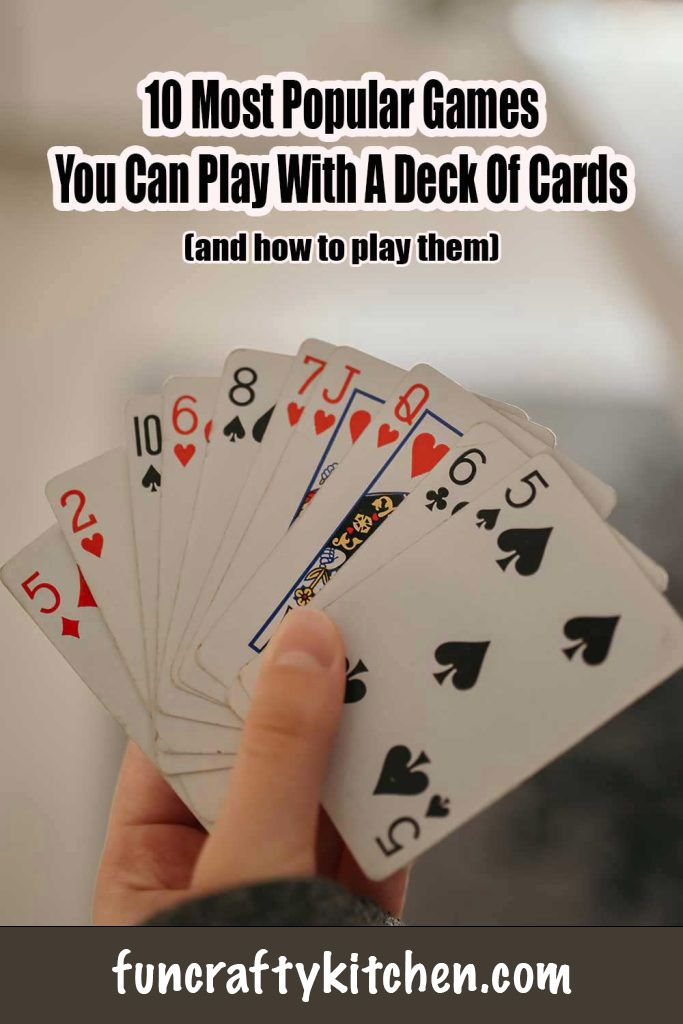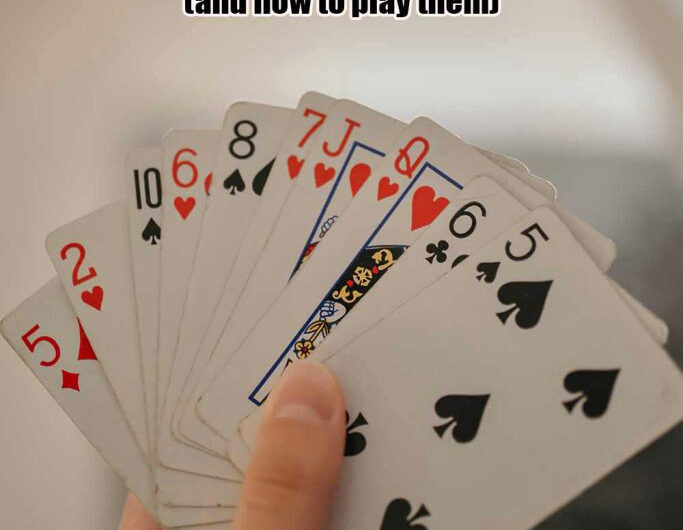10 Most Popular Games You Can Play With A Deck Of Cards
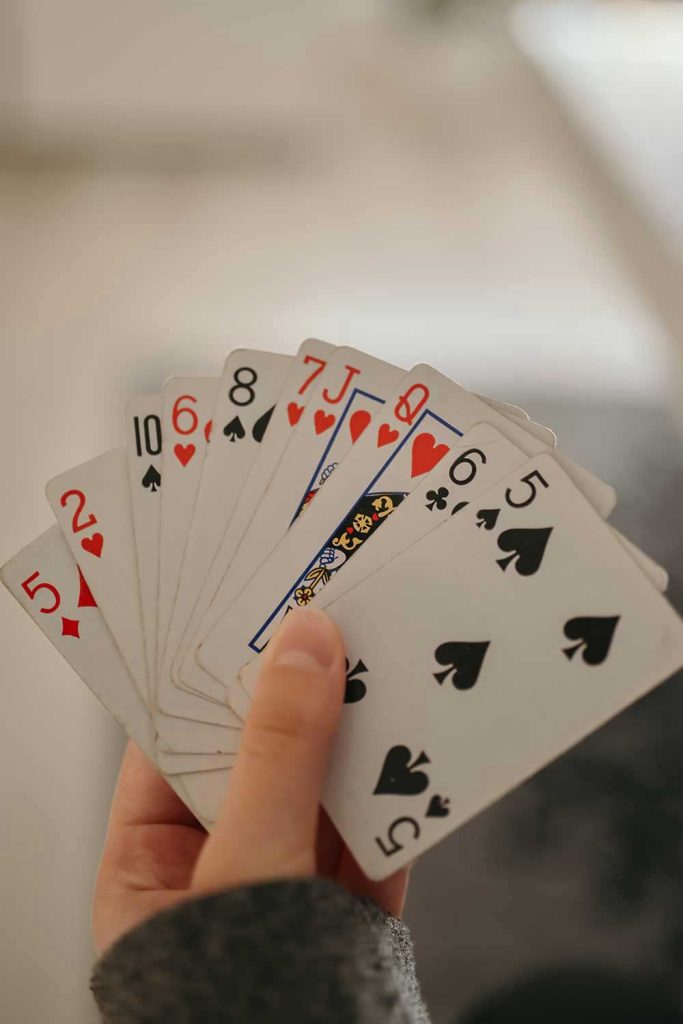
A simple deck of playing cards is a versatile and timeless source of entertainment. Whether you’re gathered with friends, family, or looking for solo amusement, a deck of cards can provide hours of fun.
In this comprehensive guide, we’ll explore the 10 most popular card games and provide step-by-step instructions on how to play each of them.
Best cards for these games:
I recommend buying Bicycle Standard Rider Back Playing Cards. They are super durable and really nice to play any card games with. You get 2 packs for the price of one!
1. Poker:
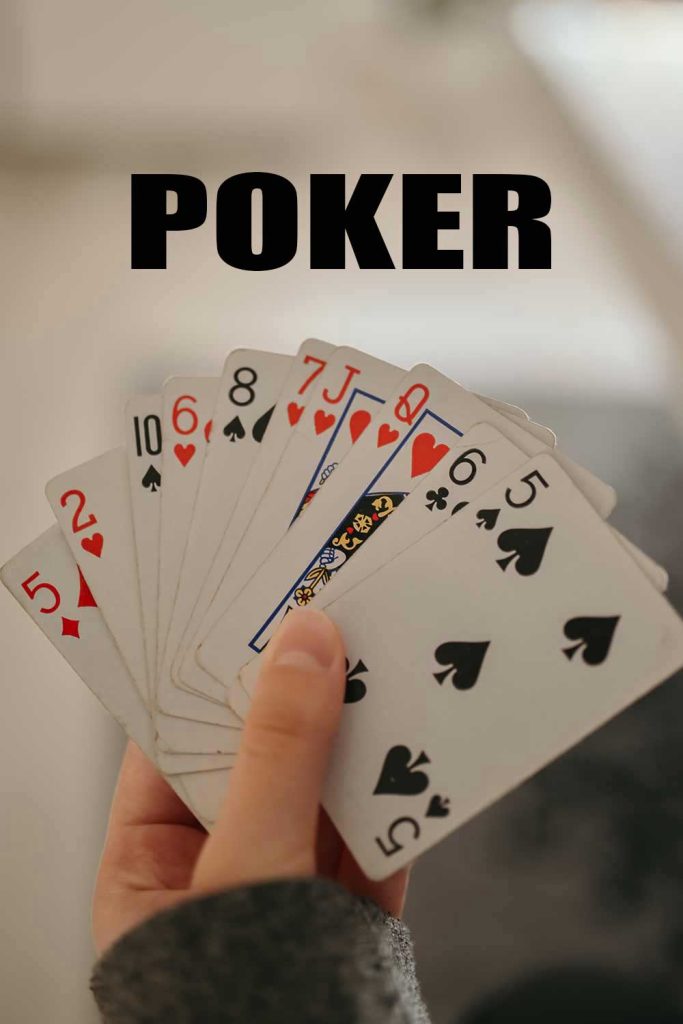
Poker is a beloved card game with numerous variations, such as Texas Hold’em and Omaha. The objective is to form the best five-card hand. Players bet, raise, or fold in turn, creating a dynamic and strategic game of skill and luck.
How to play poker:
The objective of Texas Hold’em is to win chips or money by either having the best hand at showdown or by convincing your opponents to fold their hands.
Setup:
- Gather a standard 52-card deck and poker chips (or use any form of currency).
- Assign a dealer position. You can rotate this position clockwise after each hand.
Basic Rules: Texas Hold’em is typically played with 2 to 10 players. The game consists of several rounds of betting and the following steps:
1. Blinds and Antes:
- In a home game, you can use blinds or antes to start the betting. The player to the left of the dealer posts a small blind, and the next player posts a big blind (usually double the small blind). Blinds are forced bets that initiate the action.
2. Hole Cards:
- Each player is dealt two private cards (hole cards) face down. These cards are for your eyes only.
3. The First Betting Round (Pre-flop):
- Starting with the player to the left of the big blind, each player has three options:
- Fold: Discard your hand and forfeit the round.
- Call: Match the amount of the big blind.
- Raise: Increase the bet by adding more chips to the pot.
4. The Flop:
- After the pre-flop betting, the dealer reveals the first three community cards in the center of the table. These cards are called the “flop.”
5. The Second Betting Round (Post-flop):
- The player to the left of the dealer (or the last player to bet in the pre-flop round) starts the betting. Players can check, bet, call, raise, or fold, as in the pre-flop round.
6. The Turn:
- The dealer reveals a fourth community card, called the “turn,” in the center of the table.
7. The Third Betting Round (Post-turn):
- Betting proceeds as in the previous rounds.
8. The River:
- The dealer reveals a fifth and final community card, called the “river.”
9. The Final Betting Round (Post-river):
- The last round of betting takes place, following the same rules as the previous rounds.
10. Showdown:
- If there are two or more players remaining after the final betting round, they reveal their hole cards, starting with the last player to bet or raise. The player with the best five-card hand, using any combination of their two hole cards and the five community cards, wins the pot.
Hand Rankings: In Texas Hold’em, the player with the highest-ranking hand wins. The hand rankings, from highest to lowest, are as follows:
- Royal Flush
- Straight Flush
- Four of a Kind
- Full House
- Flush
- Straight
- Three of a Kind
- Two Pair
- One Pair
- High Card
Winning the Pot: The player with the best hand wins the chips or money in the pot. If two or more players have the same hand, the pot is split evenly among them.
2. Bridge:
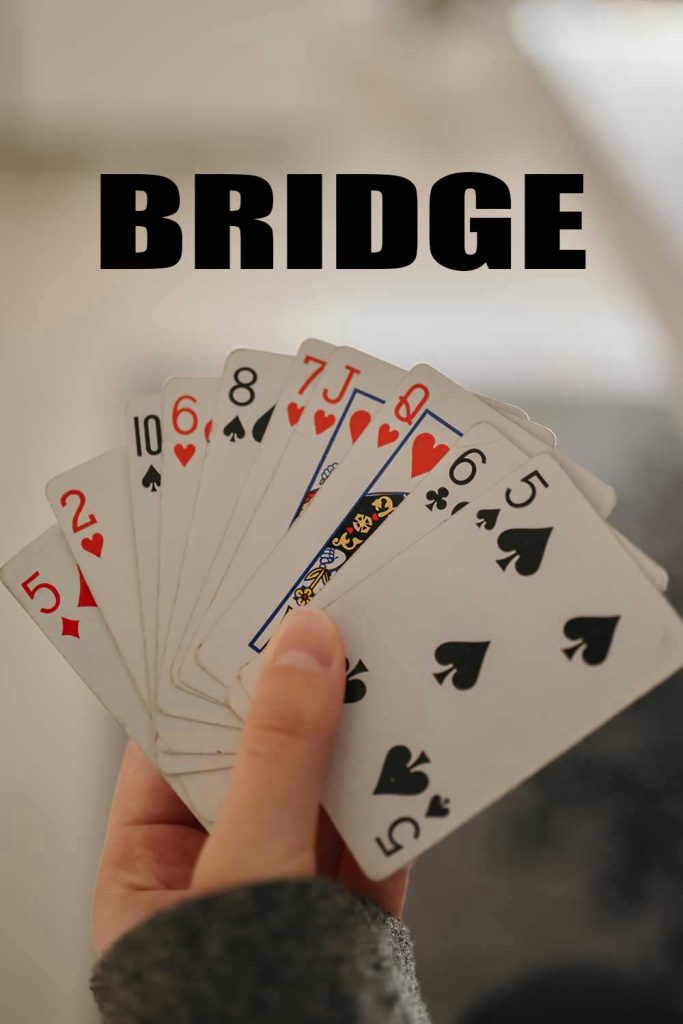
Bridge is a trick-taking game for four players. It requires teamwork and communication, as players form two partnerships. The goal is to win as many “tricks” as possible. The game involves bidding, trump suits, and careful cardplay.
How to play bridge:
The primary objective of bridge is to score points by taking tricks during the play of the hand and fulfilling your bid contract.
Setup:
- Gather a standard 52-card deck.
- Assign partnerships by drawing cards. The two highest cards become one partnership, and the two lowest cards become the other.
- Decide who will be the dealer. The dealer rotates clockwise after each hand.
Basic Rules:
Bridge is played in several phases:
1. Dealing:
- The dealer shuffles the deck and offers it to the player to their right for a cut.
- The dealer then distributes the cards, starting with the player to their left, in a clockwise direction, giving each player 13 cards.
2. Bidding:
- Bidding is a crucial part of bridge and determines the contract for the hand. It involves predicting how many tricks a partnership expects to take.
- Bidding starts with the dealer and proceeds clockwise. Players make bids by stating the number of tricks they plan to win and the trump suit (or “no trump”).
- The minimum bid is one trick, and bids go up in one-trick increments.
- A bid consists of two parts: the number of tricks (e.g., “two spades” means the partnership plans to win two tricks with spades as the trump suit).
- Players can also “pass” if they don’t want to bid.
- Bidding continues until three consecutive players pass.
3. The Play:
- The player who won the bid (the “declarer”) will try to fulfill the contract.
- The player to the left of the declarer leads the first trick by playing a card.
- Players must follow suit (play a card of the same suit as the leading card) if they can; otherwise, they can play any card.
- The highest card of the led suit wins the trick unless a trump card is played, in which case the highest trump card wins.
- The declarer collects tricks for their partnership as long as they fulfill their contract. Tricks are placed face down.
- After all tricks are played, the declarer and the defenders count their tricks.
4. Scoring:
- Scoring in bridge can be complex but is based on how many tricks the declarer’s partnership fulfilled their contract by taking.
- A contract may be at a specific level (e.g., 3 spades) or “no trump.”
- Points are awarded for fulfilling the contract and bonuses for overtricks and undertricks.
- The objective is to accumulate points over multiple hands.
5. Rotation and Play Continuation:
- After scoring, the deal rotates to the left, and a new hand begins.
- The game continues for a predetermined number of hands, with the goal of accumulating points.
3. Solitaire:
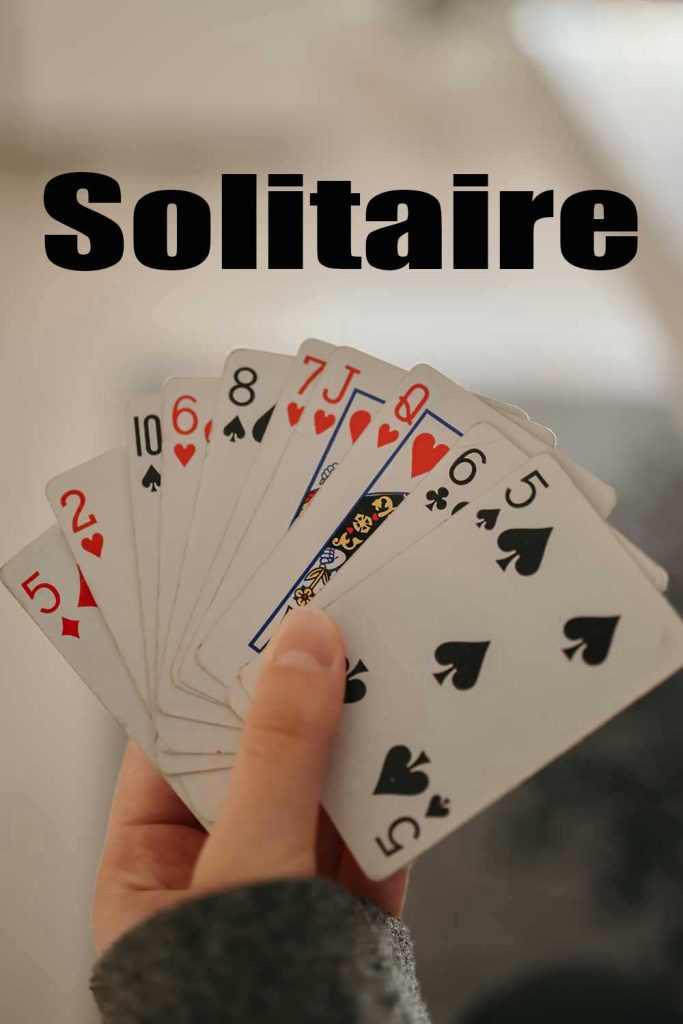
Solitaire is a classic single-player card game. The objective is to move all the cards to foundation piles, following specific rules for stacking cards by rank and alternating colors. Patience and strategy are key to success.
How to play Solitaire:
The goal of Solitaire is to arrange all the cards in four foundation piles, each by suit and in ascending order (from Ace to King).
Setup:
- You’ll need a standard 52-card deck.
- Shuffle the deck thoroughly.
- Deal 28 cards into seven tableau columns in the following manner: The first column has one card, the second column has two cards (one face down and one face up), the third column has three cards (two face down and one face up), and so on, until the seventh column has seven cards (six face down and one face up).
- Place the remaining cards face down to form a draw pile.
Basic Rules:
Solitaire is played in several phases:
1. Moving Cards:
- You can move cards in the following ways:
- Move cards from the tableau columns to build descending sequences of alternating colors (e.g., a black 7 can be placed on a red 8).
- Move cards from the tableau columns to the foundations, starting with the Ace of each suit.
- Flip over face-down cards in the tableau columns to reveal and use the hidden cards beneath.
- Move a King (or a sequence starting with a King) to an empty tableau column.
2. Building Foundations:
- The objective is to build four foundation piles, one for each suit (hearts, diamonds, clubs, and spades).
- Foundations must be built in ascending order, starting with the Ace of each suit (e.g., A, 2, 3, 4, 5, 6, 7, 8, 9, 10, J, Q, K).
- To move a card to a foundation pile, simply place the card in the correct order (e.g., after the Ace of Spades, you’d place the 2 of Spades).
3. Drawing Cards:
- If you can’t make any more moves in the tableau or with the cards on the foundations, you can draw cards from the draw pile.
- Draw one card at a time and place it face up on a separate discard pile.
4. Reusing the Discard Pile:
- You can go through the discard pile as many times as needed.
- When the draw pile is empty, flip the discard pile over (without shuffling) to create a new draw pile.
5. Winning the Game:
- The game is won when all four foundation piles are complete, with each containing all the cards from Ace to King, sorted by suit.
4. Hearts:
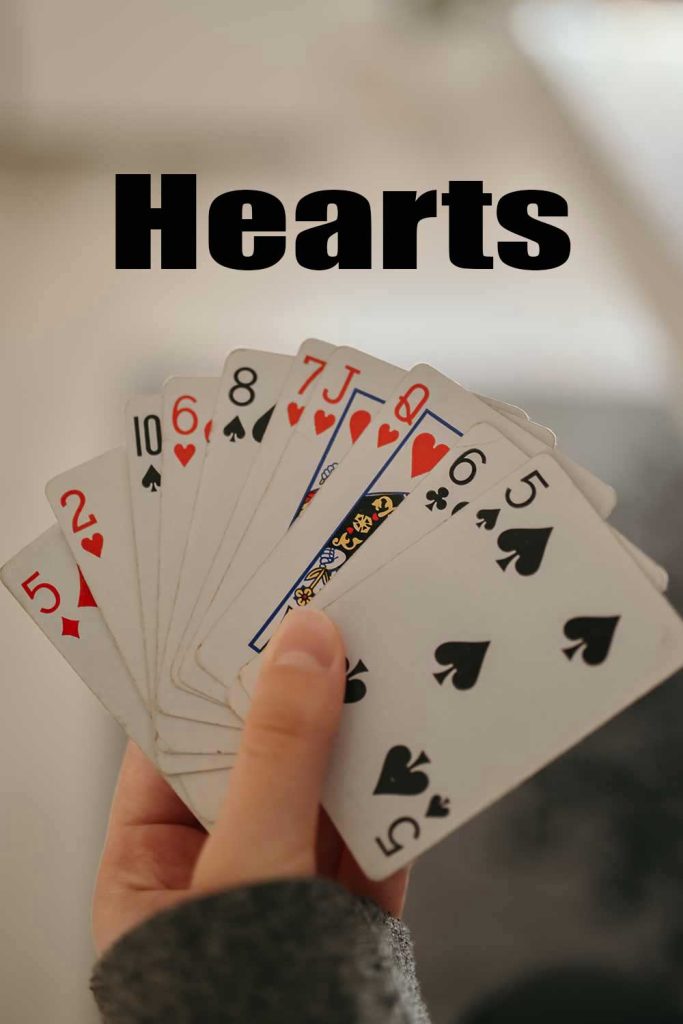
Hearts is a trick-taking game for four players. The goal is to avoid taking certain cards (hearts and the Queen of Spades) in tricks. The player with the lowest score wins. Players must carefully manage their hands and avoid penalties.
How to play Hearts:
The goal of Hearts is to have the lowest score at the end of a predetermined number of rounds. Points are acquired by taking hearts and the Queen of Spades in tricks. The player with the fewest points wins.
Setup:
- You’ll need a standard 52-card deck.
- Shuffle the deck thoroughly.
- Determine the order of play, either by drawing cards or mutual agreement. The player with the 2 of Clubs goes first, and play proceeds clockwise.
Basic Rules:
Hearts is played in several phases:
1. Dealing:
- The dealer shuffles the deck and offers it to the player to their right for a cut.
- The dealer then deals the entire deck, one card at a time, face down, to the four players. Each player receives 13 cards.
2. Passing Cards:
- Before each hand begins, players select three cards from their hand to pass to another player. The first hand, you pass to the player on your left. In subsequent hands, pass to the right, across, or not at all (depending on the round).
- The player who holds the 2 of Clubs leads the first trick.
3. Playing Tricks:
- In each trick, players must follow the suit of the leading card if they have cards of that suit. If they don’t have cards of the leading suit, they can play any card.
- The player who plays the highest card of the leading suit wins the trick and leads the next one.
- Players cannot lead with hearts or the Queen of Spades until hearts have been “broken” (played in a previous trick).
- The goal is to avoid taking hearts or the Queen of Spades in tricks, as each of these cards carries penalty points.
4. Scoring:
- Players accumulate penalty points based on the cards they’ve taken in tricks. The point values are as follows:
- Hearts: Each heart card taken is worth 1 penalty point.
- Queen of Spades: The Queen of Spades is worth 13 penalty points.
- A player can also receive 26 penalty points (the maximum possible) if they take all the hearts and the Queen of Spades in a single hand, known as “shooting the moon.”
- The objective is to have the fewest penalty points at the end of the predetermined number of rounds.
5. Winning the Game:
- The game typically consists of several rounds, with players’ scores accumulating over multiple rounds.
- The player with the lowest score at the end of the final round wins the game.
5. Spades:
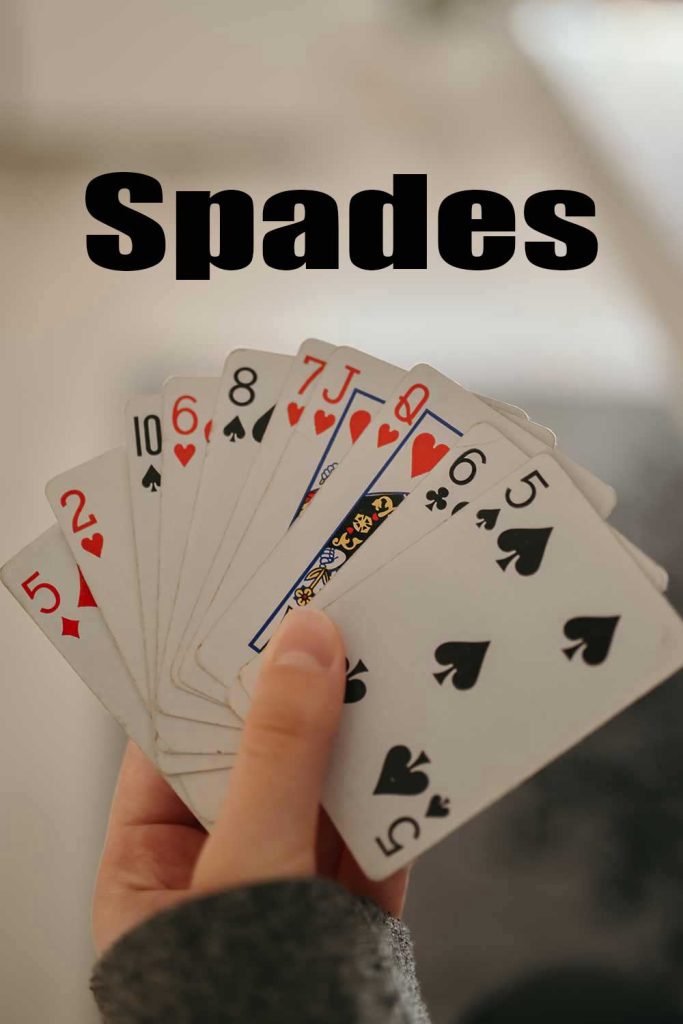
Spades is another four-player trick-taking game. Partnerships compete to take the most tricks. Players must bid the number of tricks they think they can win and follow suit, with Spades as the trump suit.
How to play Spades:
The goal of Spades is to accurately predict the number of tricks (or “books”) your partnership will take in each round and to try to fulfill that prediction while sabotaging your opponents’ predictions.
Setup:
- You’ll need a standard 52-card deck.
- Determine partnerships by drawing cards or mutual agreement. Partners sit across from each other.
- Decide on a predetermined number of rounds to play (usually 13 rounds in casual games).
- Determine the first dealer. The dealer rotates clockwise after each round.
Basic Rules:
Spades is played in several phases:
1. Dealing:
- The dealer shuffles the deck and offers it to the player to their right for a cut.
- The dealer then deals the entire deck, one card at a time, face down, to the four players. Each player receives 13 cards.
2. Bidding:
- After receiving their hands, players take turns bidding the number of tricks their partnership expects to win in the round.
- Bids can range from zero to 13.
- The player to the left of the dealer starts the bidding, and bidding proceeds clockwise.
- A player can “bid nil” if they believe they won’t win any tricks in the round. If successful, they earn a bonus, but if they win even one trick, they receive a penalty.
- The player who wins the bid (the “declarer”) has the right to lead the first trick.
3. Playing Tricks:
- In each trick, players must follow suit (play a card of the same suit as the leading card) if they have cards of that suit. If they don’t have cards of the leading suit, they can play any card.
- The highest card of the leading suit wins the trick.
- Players must always play a Spade if they have one, once Spades have been “broken” (played in a previous trick). If a player cannot follow suit, they may play any Spade.
- The objective is to accurately predict and win the number of tricks bid.
4. Scoring:
- Scoring in Spades is based on the number of tricks won relative to the bid.
- If a partnership fulfills its bid, they receive 10 points per trick bid.
- If a partnership fails to fulfill its bid, they lose 10 points per trick bid.
- Nil bids, when successful, earn the declarer’s partnership 100 points, but if they fail to win even one trick, they lose 100 points.
- The game continues for the predetermined number of rounds, and scores accumulate.
5. Winning the Game:
- The game concludes after the predetermined number of rounds.
- The partnership with the highest score wins.
6. Crazy Eights:
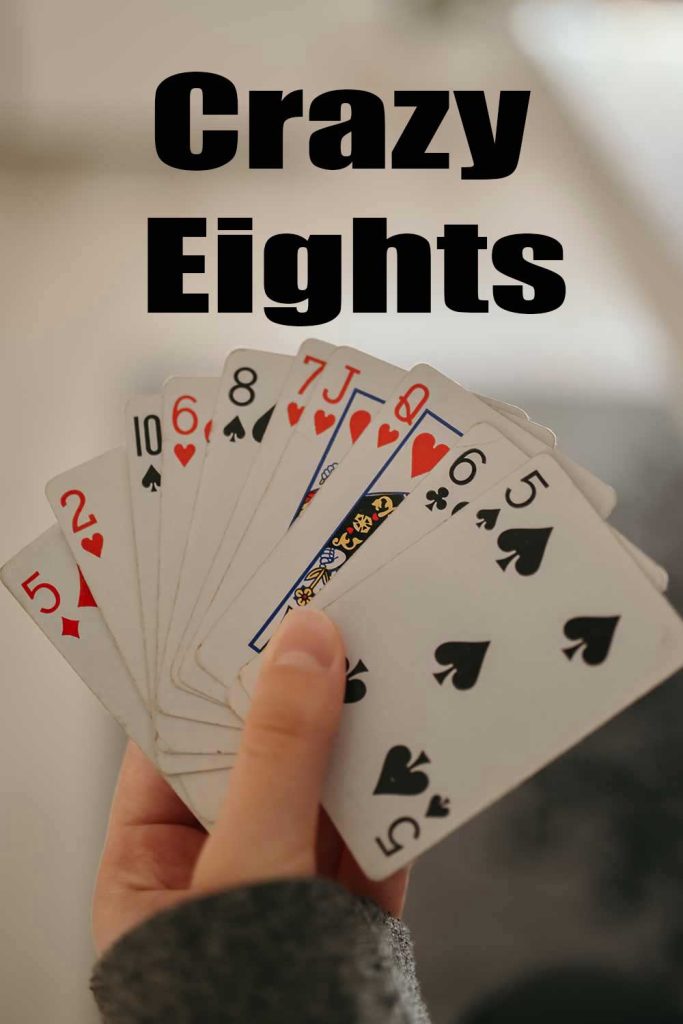
Crazy Eights is a simple and fun game for 2 or more players. The objective is to be the first to play all your cards. Players match cards by rank or suit, and “8s” are wild cards that allow you to change the suit.
How to play Crazy Eights:
The goal of Crazy Eights is to be the first player to get rid of all their cards by matching the rank or suit of the top card on the discard pile.
Setup:
- You’ll need a standard 52-card deck.
- Determine the order of play, either by drawing cards or mutual agreement. The player with the highest-ranked card goes first, and play proceeds clockwise.
Basic Rules:
Crazy Eights is played in several phases:
1. Dealing:
- The dealer shuffles the deck and offers it to the player to their right for a cut.
- The dealer then deals a hand of 5 cards to each player. If there are only two players, deal 7 cards to each.
2. The Discard Pile:
- Place the remaining deck face down to form the draw pile.
- Turn the top card from the draw pile face up to start the discard pile next to it. This card is the starting point for the game.
3. Playing Cards:
- Players take turns playing one card at a time onto the discard pile.
- A player can play a card if it matches either the rank or the suit of the top card on the discard pile.
- For example, if the top card is a 7 of Diamonds, you can play any 7 or any Diamond card from your hand.
- If a player cannot play a card that matches the rank or suit, they must draw a card from the draw pile. If that drawn card can be played, the player can play it immediately. If not, play passes to the next player.
4. Crazy Eights:
- Eights are special cards in Crazy Eights. They can be played at any time, regardless of the top card’s rank or suit.
- When you play an Eight, you must declare the new suit you want the game to continue with.
- For example, if the top card is a 10 of Hearts, and you play an Eight, you can declare that the new suit is Spades, and the next player must play a Spade card or another Eight.
5. Winning the Game:
- The first player to empty their hand of cards wins the game.
Additional Rules:
- Some variations of Crazy Eights include penalty points for unplayed cards in your hand when someone else goes out (e.g., 10 points for each remaining card).
- You can also play multiple rounds and keep score, with the first player to reach a predetermined score being the overall winner.
7. Go Fish:
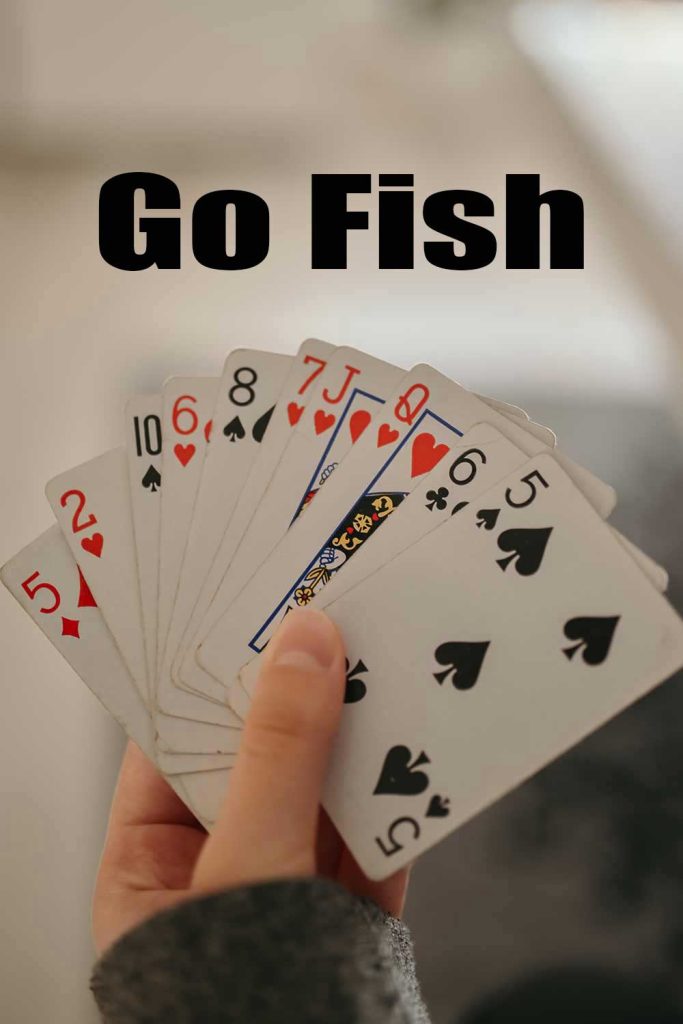
Go Fish is a great game for children and casual players. The goal is to collect sets of four cards of the same rank. Players ask each other for specific cards, and if they don’t have them, they must “Go Fish” from the draw pile.
How to play Go Fish:
The goal of Go Fish is to collect as many sets of four cards of the same rank (four-of-a-kind) as possible.
Setup:
- You’ll need a standard 52-card deck.
- Determine the dealer. You can do this by drawing cards or mutual agreement. The dealer shuffles the deck and offers it to the player on their right for a cut.
- The dealer then deals 5 cards to each player if there are 4 or more players, and 7 cards if there are 3 or fewer players.
- The remaining cards form the draw pile, placed face down in the center of the table.
Basic Rules:
Go Fish is played in several phases:
1. Starting the Game:
- The player to the dealer’s left goes first. Play proceeds clockwise.
- Players take turns asking any other player for a specific rank of card (e.g., “Do you have any 4s?”).
- The player making the request must already have at least one card of the rank they are asking for.
2. Making Pairs:
- If the player being asked has one or more cards of the requested rank, they must give all the cards of that rank to the player who asked.
- The player who asked for the cards can then go again, asking any player for a different rank.
- If the player being asked does not have any cards of the requested rank, they say, “Go Fish!” The player who asked must then draw one card from the draw pile.
- If the drawn card is the rank they were looking for, they get another turn. If not, play passes to the next player.
3. Collecting Sets:
- Whenever a player collects four cards of the same rank (a set), they place the set face up in front of them.
- Sets can be collected at any time during a player’s turn.
4. Winning the Game:
- The game continues until all sets of four cards have been collected from the players’ hands.
- The player with the most sets (four-of-a-kind) at the end of the game wins.
Additional Rules:
- Some variations allow players to “fish” for the same rank they just collected a set of, while others require them to wait until their next turn to request a new rank.
- You can play multiple rounds and keep score, with the player who collects the most sets over several rounds being the overall winner.
8. Rummy:
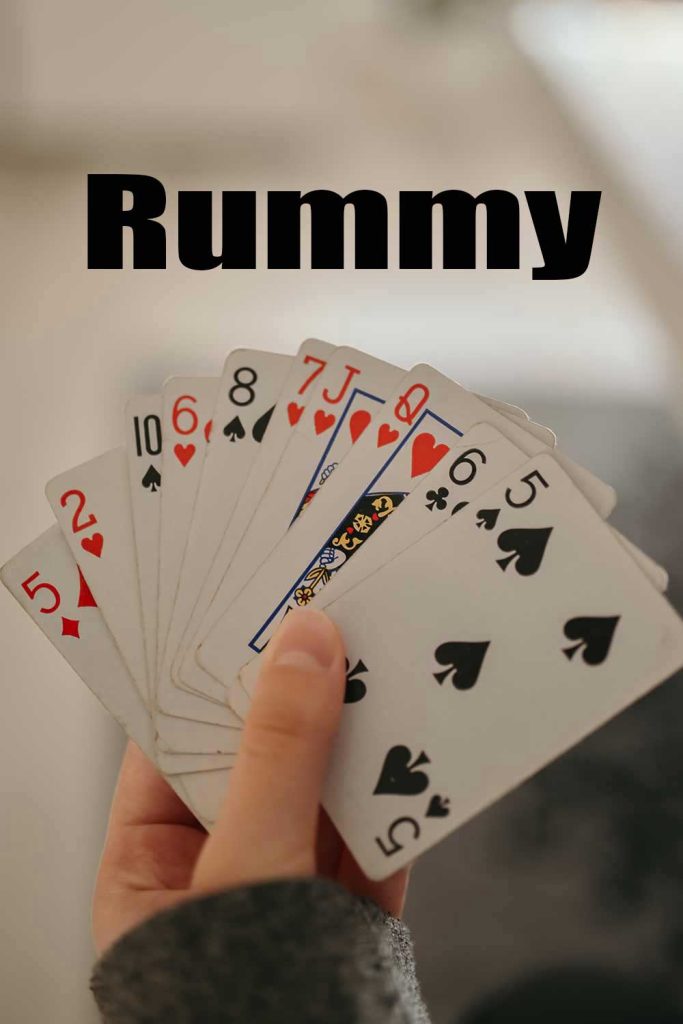
Rummy is a group of matching-card games where players form sets or runs of cards in their hands. The most common variation is Gin Rummy. Players aim to create valid combinations and minimize deadwood points.
How to play Rummy:
The primary goal of Rummy is to form valid combinations of cards in your hand, such as sets (three or four cards of the same rank) and runs (three or more consecutive cards of the same suit). The player who goes out first, with no cards left in their hand, wins the round.
Setup:
- You’ll need a standard 52-card deck.
- Determine the dealer. You can do this by drawing cards or mutual agreement. The dealer shuffles the deck and offers it to the player to their right for a cut.
- The dealer then deals a specific number of cards to each player, depending on the variation being played. In standard Rummy, players are usually dealt 10 cards each in a 2-player game, 7 cards each in a 3-4 player game, and 6 cards each in a 5-6 player game. The remaining cards form the draw pile, placed face down in the center of the table, with the top card turned face up to start the discard pile.
Basic Rules:
Rummy is played in several phases:
1. Taking Your Turn:
- On your turn, you must start by drawing one card. You can draw either from the draw pile or the discard pile.
- If you draw from the discard pile, you must take the top card and any other cards on top of it.
- After drawing, you may choose to lay down valid sets and runs from your hand. This is optional and can be done at any time during your turn.
- To form sets and runs, place the required cards face up on the table. Make sure your opponents can see and verify your combinations.
- Finally, you must end your turn by discarding one card onto the discard pile.
2. Winning the Game:
- The game continues with players taking turns, drawing, laying down sets and runs, and discarding until one player goes out by forming valid combinations with all their cards.
- When a player goes out, all other players reveal their remaining cards, and the player who went out wins the round. The winning player earns points based on the value of cards left in the opponents’ hands.
- Points are typically assigned as follows: numbered cards (2-10) are worth their face value, face cards (Jack, Queen, King) are worth 10 points each, and Aces are worth 1 point each.
- The game can be played over multiple rounds, and the player with the lowest score at the end of the predetermined number of rounds is the overall winner.
9. Crazy Pineapple:
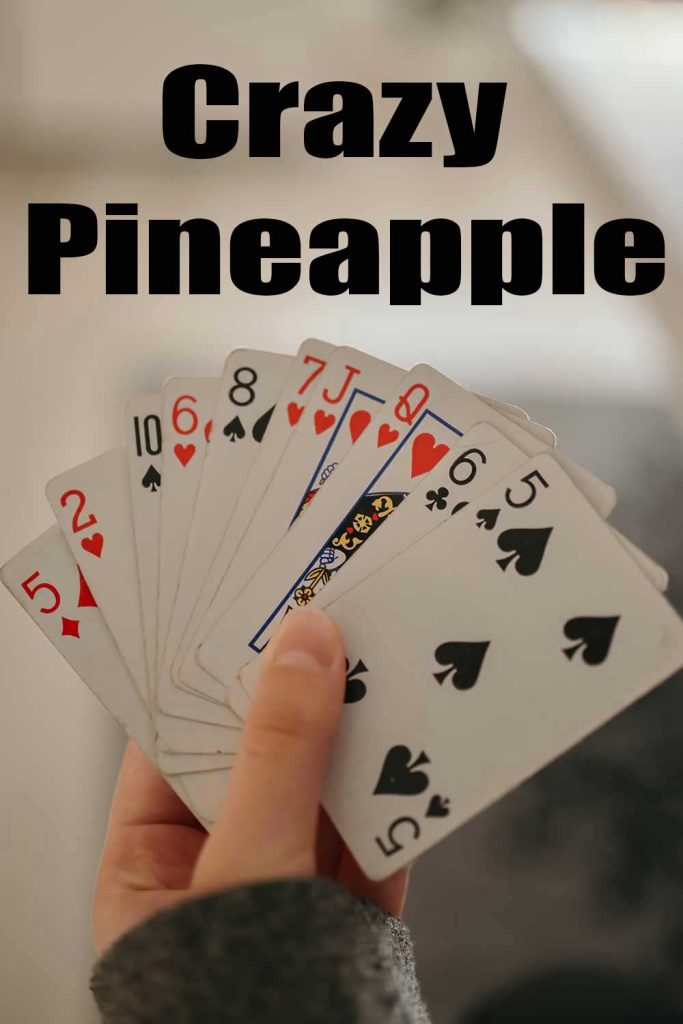
Crazy Pineapple is a variation of Texas Hold’em Poker. Each player is dealt three hole cards instead of two. After the flop, players must discard one card, adding an extra layer of strategy to the game.
How to play Crazy Pineapple:
The goal of Crazy Pineapple is the same as traditional Texas Hold’em – to have the best five-card poker hand and win the pot.
Setup:
- You’ll need a standard 52-card deck.
- Determine the dealer. You can do this by drawing cards or mutual agreement. The dealer shuffles the deck and offers it to the player to their right for a cut.
- The dealer then deals three hole cards face down to each player.
Basic Rules:
Crazy Pineapple is played in several phases:
1. Pre-flop Betting:
- Starting with the player to the left of the dealer, each player has the option to fold, call (match the current bet), or raise (increase the bet).
- Once all bets are equalized, the dealer proceeds to the next phase.
2. The Flop:
- The dealer reveals three community cards in the center of the table, known as the “flop.” These cards are shared by all players.
- After seeing the flop, each player must choose one hole card to discard, leaving them with two hole cards.
3. Post-flop Betting:
- Betting resumes with the player to the left of the dealer. Players can check (if no bet has been made), bet, call, raise, or fold as usual.
4. The Turn:
- The dealer reveals a fourth community card, known as the “turn.” This card is added to the flop cards, creating a total of four community cards on the table.
5. Post-turn Betting:
- Betting continues with the same options as before.
6. The River:
- The dealer reveals a fifth and final community card, known as the “river.” This card is added to the previous four community cards.
7. Final Betting Round:
- The final round of betting takes place, following the same rules as previous rounds.
8. Showdown:
- If there are two or more players remaining after the final betting round, they reveal their hole cards, using two of their three hole cards and the five community cards to form the best possible five-card poker hand.
9. Determining the Winner:
- The player with the best five-card hand wins the pot. Hand rankings in Crazy Pineapple are the same as in Texas Hold’em, with Royal Flush being the highest and High Card being the lowest.
10. Winning the Pot:
- The player with the best hand takes the pot. If multiple players have the same hand, the pot is split evenly among them.
10. War:
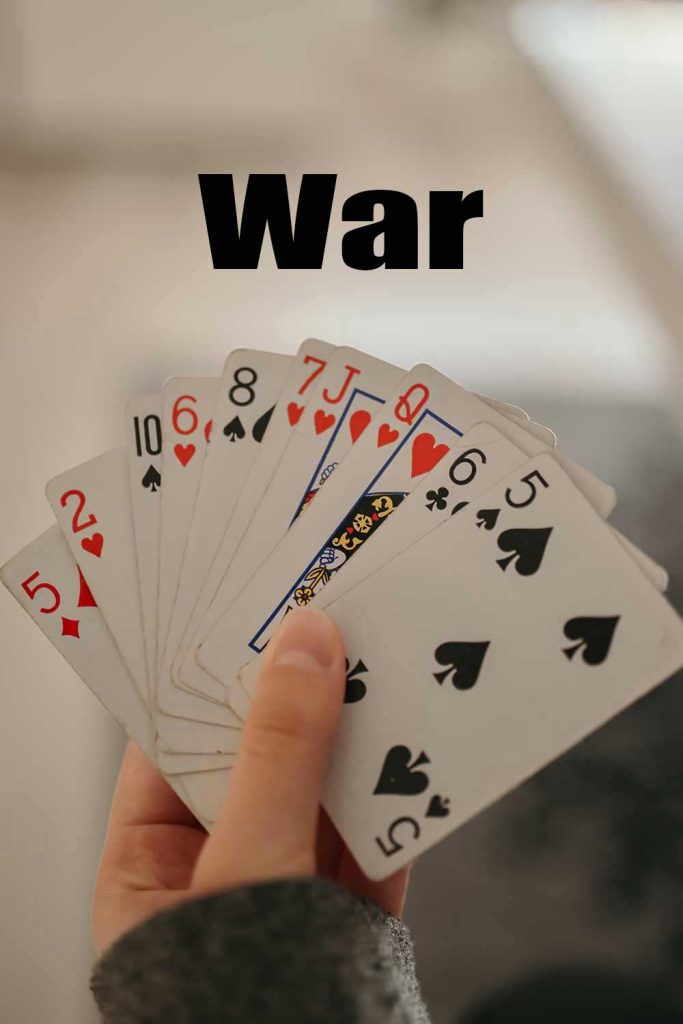
War is a simple two-player game where the entire deck is evenly divided. Players reveal the top card of their deck simultaneously, and the player with the higher card wins both cards. The objective is to collect all the cards.
How to play War:
The goal of War is to win all the cards in the deck by defeating your opponent in a series of battles.
Setup:
- You’ll need a standard 52-card deck.
- Shuffle the deck thoroughly.
- Deal the entire deck evenly between the two players. Each player should have their own stack of cards, face down, in front of them. This becomes their draw pile.
Basic Rules:
War is played in several phases:
1. Battling:
- Both players simultaneously turn over the top card from their draw pile and place it face up in the center of the table.
- The player with the higher-ranked card wins the battle and takes both cards, placing them at the bottom of their own stack.
- If the two cards are of equal rank, a “war” is declared. In a war, each player places three cards face down on top of their face-up card, followed by one face-up card. These face-up cards are compared, and the player with the higher-ranked face-up card wins all the cards in the center.
- If another tie occurs during a war, the process is repeated until a winner is determined.
2. Winning the Game:
- The game continues with players taking turns battling until one player has won all the cards in the deck. That player is declared the winner.
Additional Rules:
- Some variations of War include “double wars” or “multiple wars” in case of consecutive ties. In this case, players may have to place more cards face down before revealing another face-up card to determine the winner.
More interesting articles from us:
Super EASY Fettuccine Alfredo Recipe
Orange Creamsicle Pie Recipe
How To Crochet Your Own Miniature Elephant
How To Revive Cutting Boards And Why You SHOULD
The Ultimate Stainless Steel Fingerprint Hack
BBQ Chicken Slider Sandwiches
